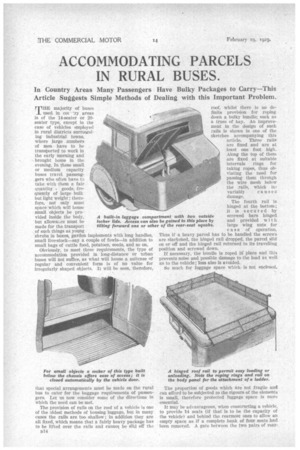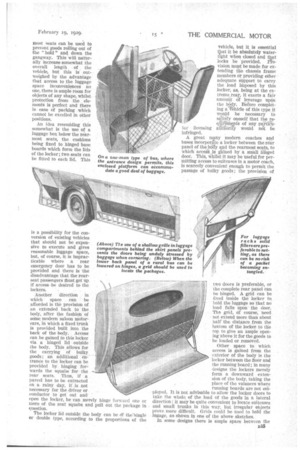ACCOMMODATING PARCELS IN RURAL BUSES.
Page 104

Page 105

Page 106

If you've noticed an error in this article please click here to report it so we can fix it.
In Country Areas Many Passengers Have Bulky Packages to Carry—This Article Suggests Simple Methods of Dealing with this Important Problem.
THE majorityof buses used. in cot -try areas is of the 14-seater or 20seater type, except in the case of vehicles employed in rural districts surrounding industrial towns, where large numbers of men. have to be transported to work in the early morning and brought home in the evening. In these small or medium capacity buses travel passenggets who often have to take with them a fair quantity ' goods, frequently of large bulk but light weight ; therefore, not only must space which will house small objects be provided inside the body. but allowa:..ce must be made for the transport of such things as young shrubs in boxes, garden implements with long handles, small live-stock—say a couple of fowls—in addition to small bags of cattle food, potatoes, seeds, and so on.
Obviously, to meet these requirements, the type of accommodation provided in long-distance or urban buses will not suffice, as what will house a suitcase of regular and convenient form is of no value for irregularly shaped objects. It will be seen, therefore, that special arrangements must be made on the rural bus to cater for the baggage requirements of passengers. Let us now consider some of the directions in which the need can be met.
The provision of rails on the roof of a vehicle is one of the oldest methods of housing luggage, but in many cases the rails are too shallow ; in addition they are all fixed, which means that a fairly heavy package has to be lifted over the rails and cannot be slid off the D14 roof, whilst there is no de finite provision for roping down a bulky bundle, such as a truss of hay. An improve ment in the design of such rails is shown in one of the N. sketches accompanying this article. Three rails are fixed and are at least one foot high. Along the top of them are fixed at suitable intervals rings for taking ropes, thus obviating the need for passing them through the wire mesh below the rails, which in variably 'causes damage,
The fourth rail is hinged at the bottom ; it is secured by screwed bars hinged and provided w it Ii large wing nuts for ease of operation. Thus if a heavy parcel has to be handled the screws are slackened, the hinged rail dropped, the parcel slid on or off and the hinged rail returned to its travelling position and screwed down.
If necessary, the bundle is roped hi place and this prevents noise and possible damage to the load as well as to the vehicle; loss also IS avoided.
So much for luggage space which is not enclosed.
The proportion of goods which are not fragile and can afford to be subjected to the rigours of the elements is small, therefore protected luggage space is more essential.
It may be advantageous, when constructing a vehicle, to provide 14 seats (if that is to be the capacity of the vehicle) and behind the rearmost ones to allow an empty space as if a complete bank of four seats had been removed. A gate between the two pairs of rear most seats can be used to prevent goods rolling out of the " hold " and down the gangway. This will naturally increase somewhat the overall length of the vehicle, but this is outweighed by the advantage that access to the luggage space inconveniences no one, there is ample room for objects of any shape, whilst protection from the elements is perfect and there is ease of packing which cannot be excelled in other positions.
An idea resembling this somewhat is the use of a luggage box below the rearmost seats, the cushions being fixed to hinged base boards which form the lids of the locker ; two seats can be fitted to each lid. This is a possibility for the conversion of existing vehicles that should not be expensive to execute and gives reasonable luggage space, but, of course, it is impracticable where a rear emergency door has to be provided and there is the disadvantage that the rearseat passengers fnust get up if access-be desired to the lockers.
Another direction in which space can be afforded is the provision of an extended back to the body, after the fashion of set/ie. modern saloon motorcars, in which a fixed trunk is provided built into the back of the body. Access can be gained to this locker via a hinged lid outside the body. This allows for the carrying of bulky goods ; an additional en-' trance to the locker can be provided by hinging for wards the squabs for the rear seats. Thus, if a parcel has to be extracted on a. rainy day, it is not necessary for the driver or conductor to get out and open the locker, he can merely hinge forward one more of the seat squabs and pull out the package question.
The locker lid outside the body can be df the'Vngle or double type, according to the proportions of the or in
vehicle, but it is essential that it be absolutely watertight when closed and that locks be 'provided. lovision must be made for extending the chassis frame members or providing other adequate Support te carry the load imposed by this locker, as, being at the extreme. rear, it exerts a fair ftmoutit of leverage npOn the hOdy. Before completing a vehicle of this type it would be necessary to satisfy oneself that the reqifireffienth of any paiticular licensing aitiforiTY would not be infringed.
A great many modern coaches and buses incorporite a locker between the rear panel of the bi5cly and the rearmost seats, to which accelS ,is gained by a small liffiged door. This, Whilst it may be useful for perMitting access to suitcases in a motor coach, is scarcely convenient enough to permit the passage of bulky goods ; the provision of
two doors is preferable,. or he complete rear panel Can be hinged. A grid can be fixed inside the locker to hold the luggage so that no load falls upon the door. Tilt, grid, Of course; 'need not extend more than about half the distance from the is/Atom of the locker to the top to give an ample opening-above-it for the goods to
be loaded or removed. •
Other space to• which access is gained from the 'exterior of the body is the locker between the floor and the running board ; in many designs the lockers merely form a downward extension of the body, taking the place of the valances where running boards are not ern.
• Ployed. It is not advisable to allow the locker doors to take the whole, of the load of the goods in a lateral direction; it may be quite convenient to locate suitcases and small trunks in this way, but irregular objects prove more difficult. Grids could be Used to hold the lugage, as shOvvn in one of the above. sketches.
In some designs there is ample space between the D15 or in floor and the running board to provide locker room, access being gained to the space by opening the vehicle doors, that is, the lower portion of each door acts as the covering for the locker.
In the one-man-operated type of bus, where the entrance is et the front on the near side, there is very often waste space to the left of the driver behind the scuttle dash. The body might be extended to its .1111 width on the left side of the dash, that is, a box-like projection could be built into the scuttle, coming out to the width of the front wing. The space would, of
course, be enclosed, and should provide ample ream for bulky but light goods in an otherwise wasted space.
Naturally the various goods to be accommodated will not all be of the bulky type ; many, such as umbrellas, coats and a hundred-and-one odd articles obtained in a day's shopping,will be considerably smaller. To house these, luggage racks of the conventional type may he employed, but a disadvantage is that awkwardly shaped parcels are apt to jam in the meshing of the nets, and this, in turn, causes one passenger to lean over another in his effort to extract the parcel.




























































































































































































































